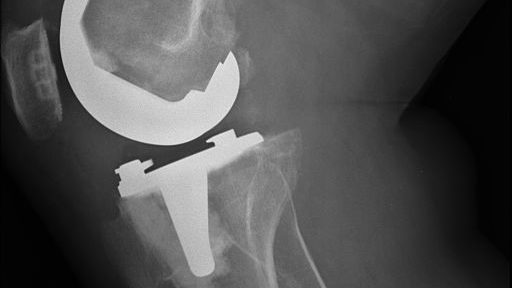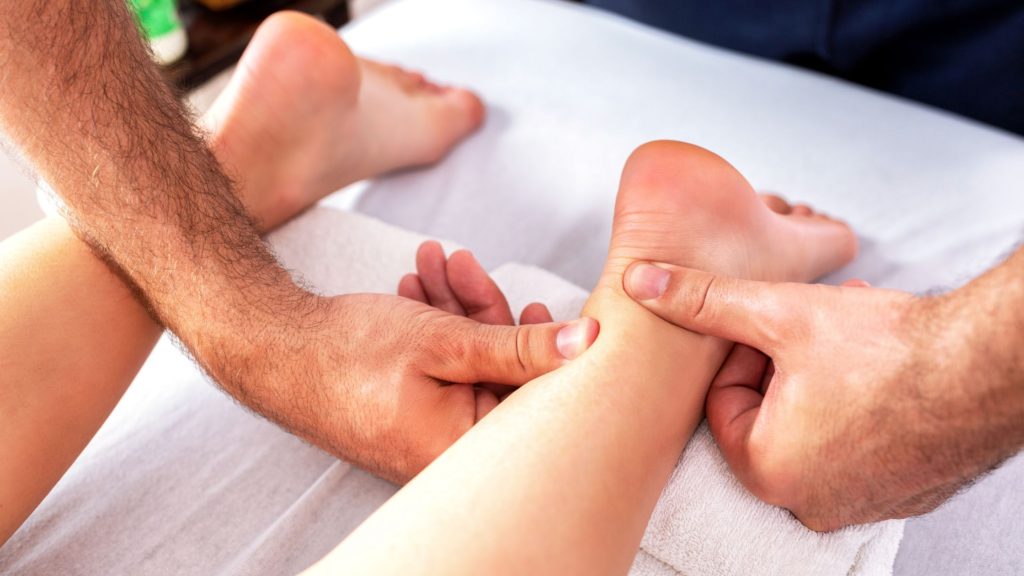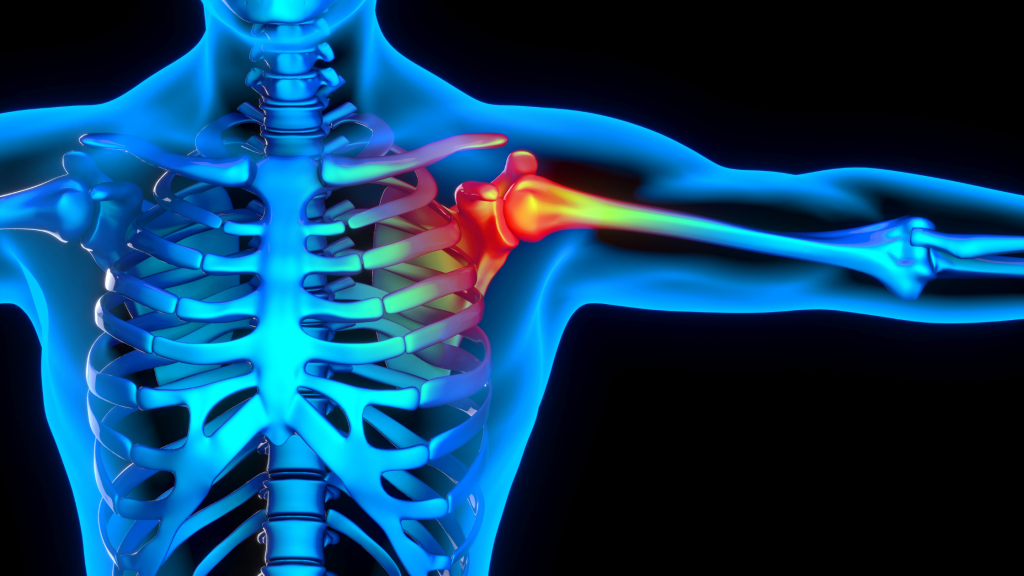Last updated on October 5th, 2022 at 05:26 pm

Ankle sprain is a common injury that affects equally the general population and athletes1. Your ankle twists suddenly while running or your foot slips while going downstairs and your foot twists. Commonly, an ankle sprain occurs on the outer side of the ankle at the lateral malleolus of the fibula, the smaller bone when the foot turns inwards. Immediately there can be swelling, and pain on the outer side.
Treatment of ankle sprain depends on the grade of the sprain. Higher grade and complete tear need surgical management, and lower grade of the sprain can be managed conservatively by exercises. In this article, we will discuss easy but effective ankle sprain exercises to cure it. We will also cover the surgical procedures at the end of this article.
Ankle sprain treatment & exercises
Exercises are important to rehabilitate back after an ankle sprain. Research has proved that exercises are effective in preventing recurrent ankle sprain2. However, initially, RICE therapy is the treatment of choice for a sprained ankle. R-I-C-E which means R- Rest, I- Ice, C- Compression, E- Elevation. The initial treatment is always RICE for ankle sprain, by doing this your inflammation reduces and healing accelerates.
But, not all ankle sprains can be managed conservatively. In grade 2 sprain or higher surgical repair is needed followed by rehabilitation exercises. At the end of this article, we will also discuss the surgical treatment of sprained ankles. In conservative management, exercises are very important after the reduction of swelling, inflammation and acute pain through the RICE protocol.
Exercises are aimed to prevent joint stiffness, and maintain ankle joint range of motion and muscle strength around the foot and ankle. It also helps in preventing swelling and inflammation. We will be covering various easy yet simple ankle strengthening and stretching exercises. So, without delay let us start with ankle range of motion exercises.
1) Ankle foot toe movement
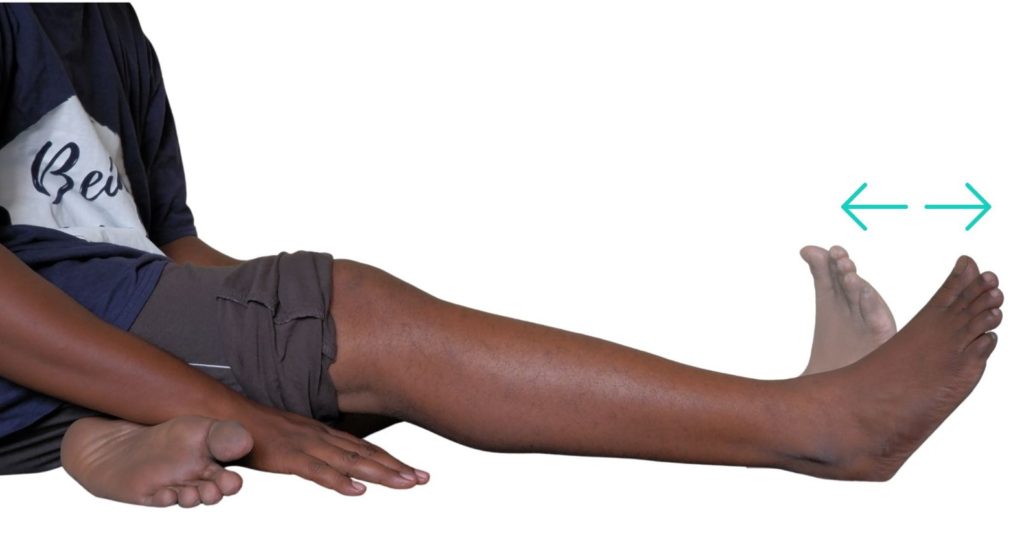
The first ankle sprain exercise is ankle foot toe movement exercise. For this exercise, you have to sit in a long sitting position. In this position you have to simply move your foot in plantarflexion and dorsiflexion motion. When you move the foot away from the body it is plantarflexion and when you bend it towards body we call it dorsiflexion. you have to simply move your ankle this way. Take the foot forward and then pull it back. This exercise will release any stiffness around the ankle. So the more you do it the better, there is no actual count to it.
2) Ankle sprain stretches
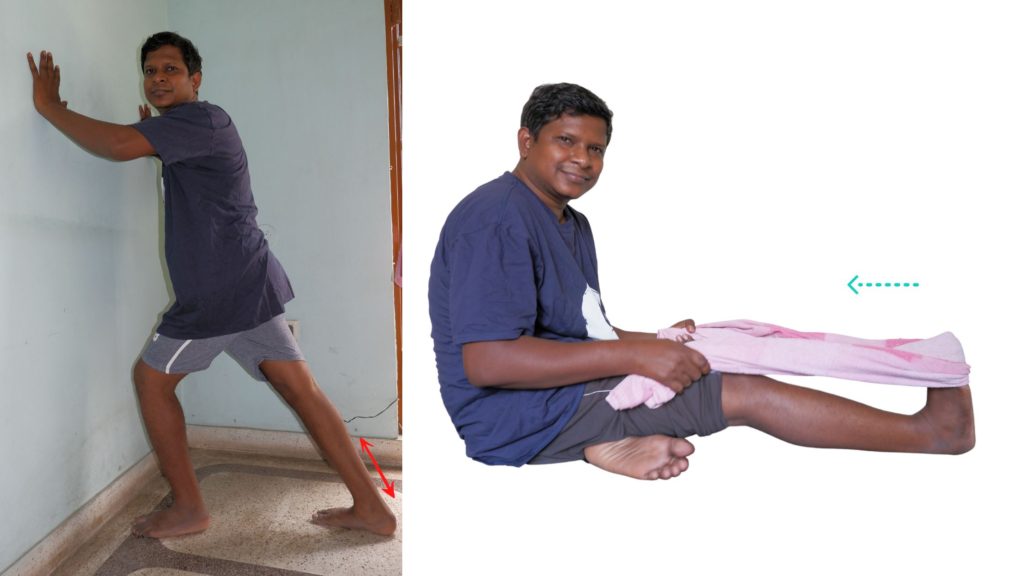
Stretching of ankle in sitting
Friends, the next exercise is the ankle stretching exercise in which we have to stretch our ankles. It’s very easy, you just need a towel or a bedsheet. Sit in a long sitting position and simply place the middle part of the towel on the ball of the toes and hold the two ends of the towel with both hands. Now pull the towel towards yourself, while doing this try not to bend the knee. When you pull it you will feel a stretch in your calf muscles.
Pull it to a point where you feel a comfortable stretch and hold this position for 30 seconds up to a minute. Then slowly release it and again repeat the same process, hold it for 30 sec to 1 minute and release it. Since it is a stretching exercise, we recommend repeating it 2 to 3 times in a single session.
In standing
As improvement happens, we have to do some stretching exercises also. For exercises, you need to stand in front of a wall with your hand at shoulder level kept against the wall. Let’s say I want to exercise the calf muscles of my right leg, then I will keep my left leg forward as demonstrated in the figure. In this starting position lean towards the wall so that you will feel a comfortable stretch on your right calf. Hold this position for at least 10 seconds then relax. Repeat this 2 to 3 times and then perform the same technique to stretch the left side calf muscle. For the left side, you have to reverse the position of the leg. The left leg will remain backward and keep the right leg forward. Lean yourself against the wall to stretch the right calf muscle.
3) Ankle plantar flexor strengthening using resistance band
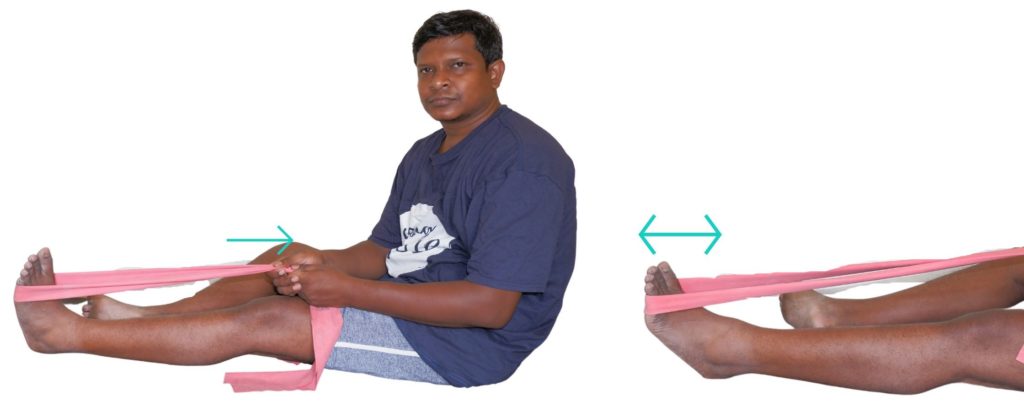
The next exercise is a strengthening exercise aimed at strengthening the muscle around the ankle. For this exercise, you will need a resistance band, a 2-meter-long band made of latex-free rubber. The starting position for this exercise would be sitting in a long sitting position. Keep the middle part of the band on the ball of your toes and hold both ends in your hands. Pull it slightly so that there is some tension on the band.
Now, in this position Then bend your ankle forward this way.
4) Foot dorsiflexor strengthening exercise for ankle sprain
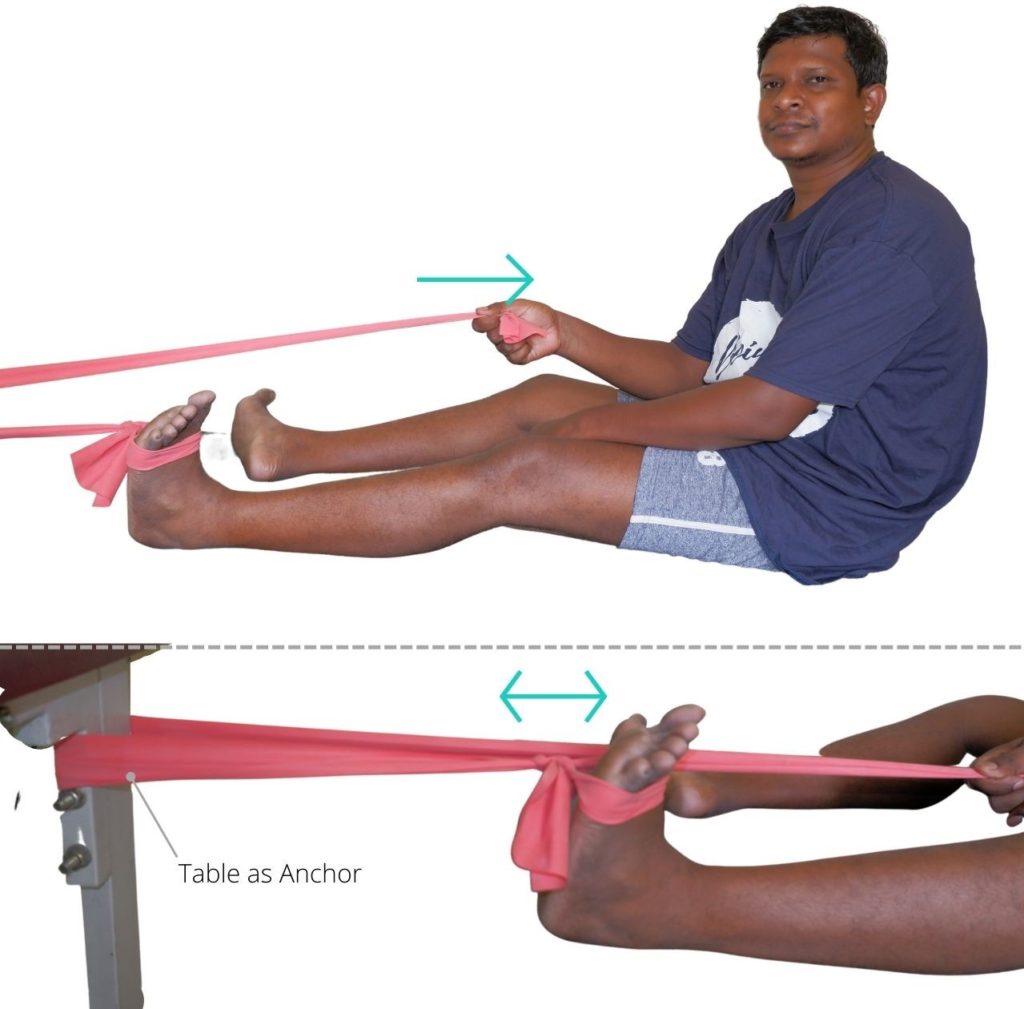
Now you have to do the reverse action, the ankle dorsiflexion motion with the resistance band. It’s simple, tie one end of the resistance band to the upper side of the foot and anchor it to a table or something in front and hold the other end with the hand. Pull the band towards yourself to create tension in the band.
In this tense position of the resistance band move your foot towards your body against the resistance of the band. Bend it and then let it relax, repeat this for a minimum of 20 repetitions in a single session.
5) Foot everter & inverter strengthening

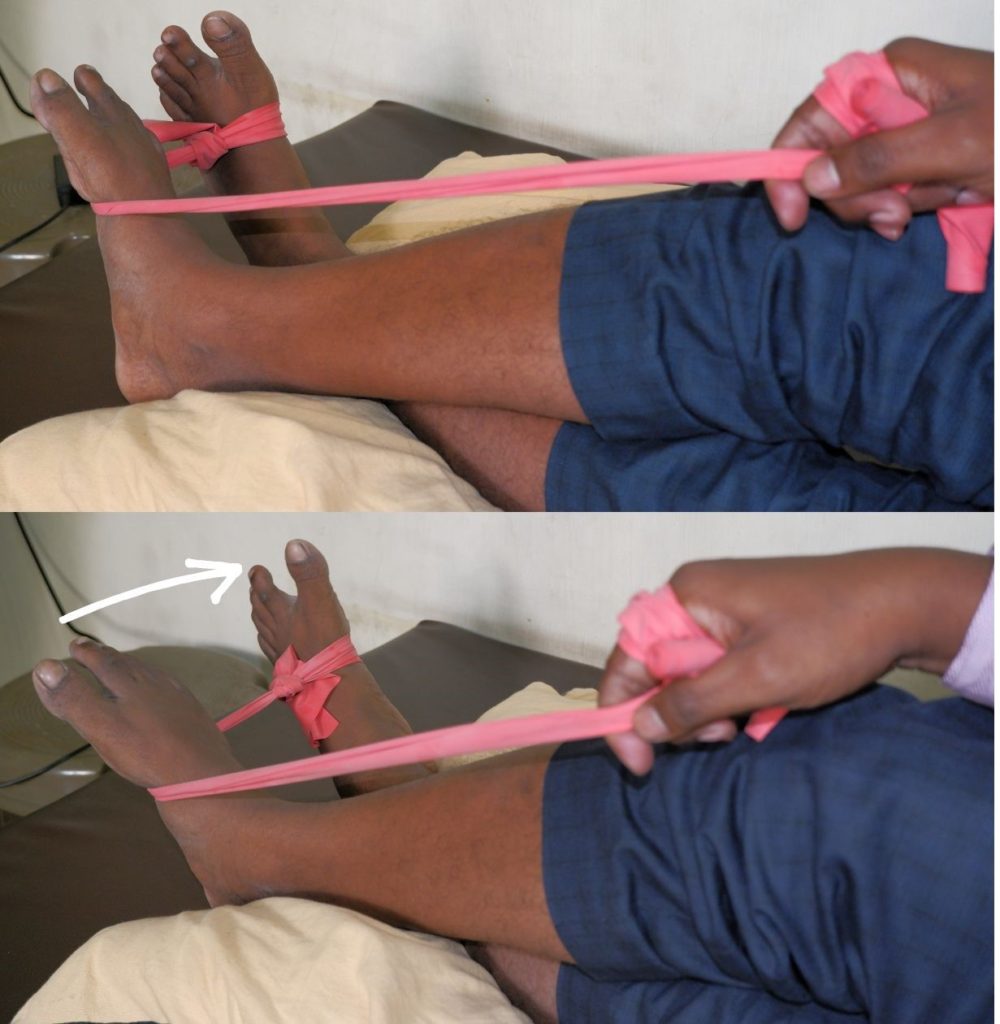
When we move our foot outside away from the midline we call it foot eversion movement. This motion of the foot is brought about by the muscles on the outer side of the lower leg, and we need to strengthen this muscle as well. This exercise is also performed in the long sitting position. In a long sitting position put a pillow under the leg and foot. Tie the one end of the resistance band at the upper part of the foot around the ball of the toes.
Anchor the resistance band to the other foot as shown in the figure. Hold the other end of the band with your hand and pull it to create slight tension on the band. Now, in this position, move the concerned foot outwards away from the midline. We call it foot eversion meaning it moves outwards. Repeat this for a minimum of 20 repetitions in a single session.
We can do it for inversion, keep the foot as I am showing and then anchor it this way and I move this foot in inversion. If you can see it properly, I am doing inversion which means I am moving the foot inwards.
6) Standing on toes ankle sprain exercises
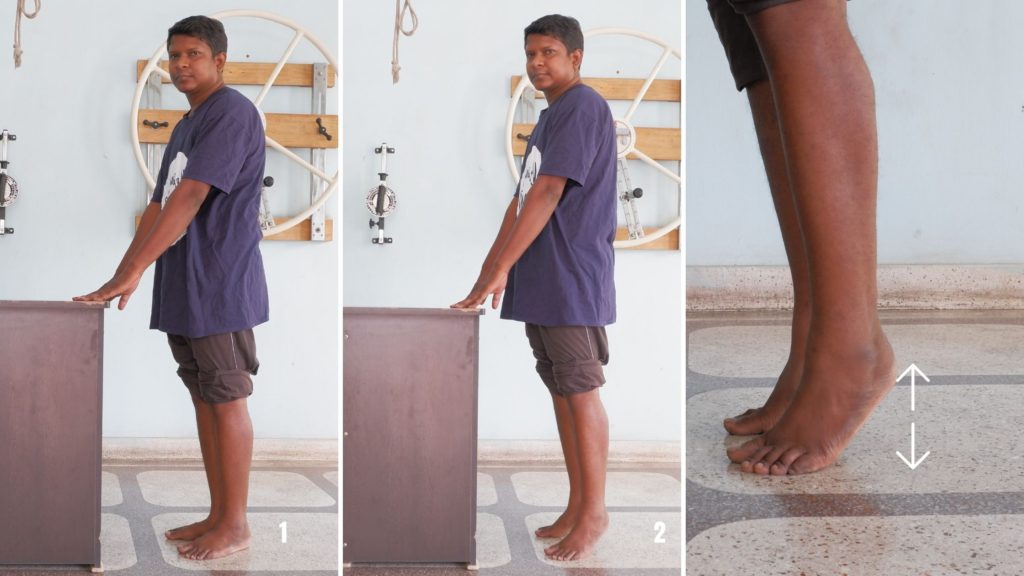
The first exercise in the standing position is standing on toes. Simply stand straight and then raise your heel off the floor. Raise yourself slowly so as to come to a standing position on your toes. Then lower yourself back to the normal standing position. Then again stand on your toes and lower yourself slowly and smoothly. Repeat this process at least 20 to 30 times in a session. However, the more you do the better it is.
This will not only improve ankle movement, but will also help strengthen the muscles around the ankle.
Which ankle sprain needs surgery
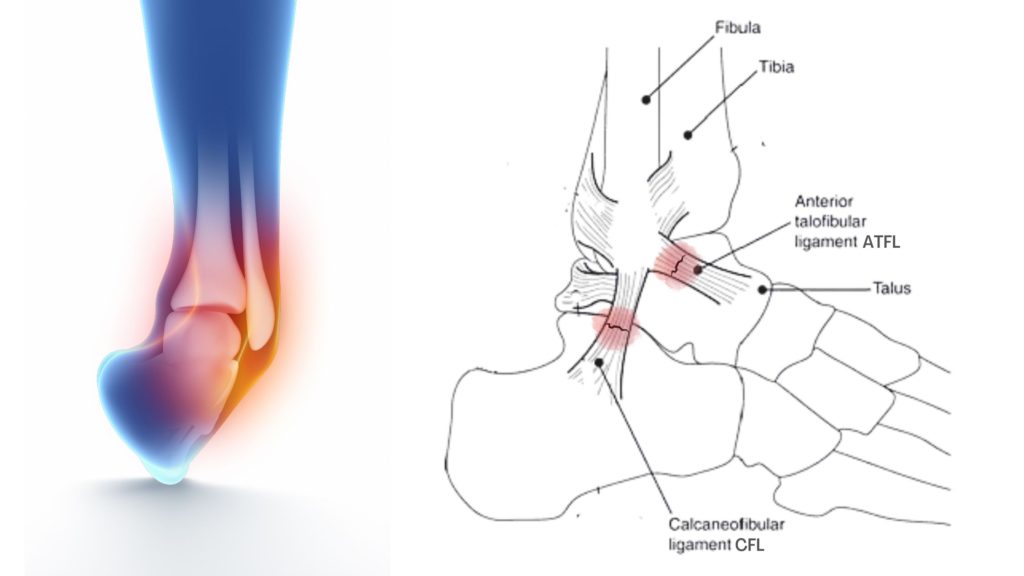
Now the question is who requires surgery after an ankle sprain. When an ankle sprain happens, when the ankle twists, some of our ligaments may get damaged. The main ligament on the outer side of the ankle is the ATFL, the Anterior Taleo-Fibular Ligament, or Calcaneo-Fibular Ligament, the CFL1. Damage to these two is very common, so if they have complete tears, there can be a recurrent ankle sprain. This recurrent sprain and ankle twisting damage the cartilage of the ankle. Once the cartilage of the ankle is damaged, there is permanent pain in the ankle and it becomes very difficult to treat.
Grade 2 ankle sprain and above requires surgery
Whether an ankle sprain needs a surgical repair or conservative management depends on the grade of ligament tear. If your MRI shows complete tear or grade 3 tear of ATFL or CFL then surgery is the preferred choice of treatment as the complete tear does not heal by itself. If your MRI shows a partial ligament injury (grade 1)5, conservative management is the first choice of treatment. In grade 2 sprain doctors mostly decide by the MRI film whether to go for surgery or to try and treat it by rehabilitation exercises.
In conservative management, the ankle is immobilised by using plaster casts or an ankle binder for 6 weeks depending upon the severity of the injury. After the 6-week the rest period, the rehabilitation period begins during which ankle strengthening exercises are done. You can follow the exercises we have discussed in this article. Exercise brings stability to your ankle.
Brostrom repair, the preferred surgery
If the MRI shows a complete tear then surgery is to be done first because the complete tear does not heal by itself. Commonly in surgical management, the Brostrom repair of ATFL and CFL is done3. In Brostrom repair, the repaired ligament takes at least 6 months to completely heal the ligament, so, to keep it safe the leg is immobilised by a plaster cast for 2 months. During plaster immobilisation, you should strictly avoid weight bearing on the operated ankle. After 2 months when the paster is removed you should start partial weight bearing and other ankle exercises.
In the Brostrom procedure, it takes about 6 months to start running. And even then the failure rate is high because if your ligament is weak for 6 months, it is not fully healed, and when you put your weight on it, there are chances of rupture of the repair. So the results of ATFL repair were not very good and there were a lot of failures.
Early return to sports possible by Brostrom repair with internal brace
This can be minimised with the internal brace technique where after repairing the ligament it is fixed with Fibre Tape for which SwiveLock is used. A study has found that Brostrom repair without internal brace took longer to return to sports whereas with internal brace technique were able to return to sport much earlier4. And 2 or 3 SwiveLock may be needed depending upon whether Internal Brace is of one ligament or ATFL and CFL both and it has Fibertape.
This construct keeps the Brostrom ligament repair safe while it’s weak. After this plaster is kept for 15 days instead of 2 months until the wound is healed. And weight bearing is started early, within a week or two. Avoiding weight bearing for long is not needed because we have already given protection to the ligament. Weight-bearing starts early, exercise starts early and the plaster stays for a very short time. With this technique, one can initiate running within 45 days which normally takes 6 months if Fibertape Internal Brace is not done.
Final words
Rehabilitation exercises after surgery are very important to get back to sports or work early. There is a set of exercises that you need to follow post-surgically, it is known as rehabilitation protocol. We will cover this protocol extensively in another article, however, if you have started walking after surgery you can follow all the exercises explained here.
Follow these exercises for 3 to 4 months regularly and you will be back to normal.
The author is a physiotherapist who has been practising for the last 17 years. He holds a Bachelor's in Physiotherapy (BPT) from SVNIRTAR (Swami Vivekananda National Institute of Rehabilitation and Research), one of the prestigious physiotherapy schools in India.
Whatever he learns dealing with his patient, he shares it with the world through blogs and e-books. He also owns a YouTube channel, "Sunit Physiotherapist" with over 8 lakh active subscribers. Here, he shares everything he gets to learn serving the patient.
